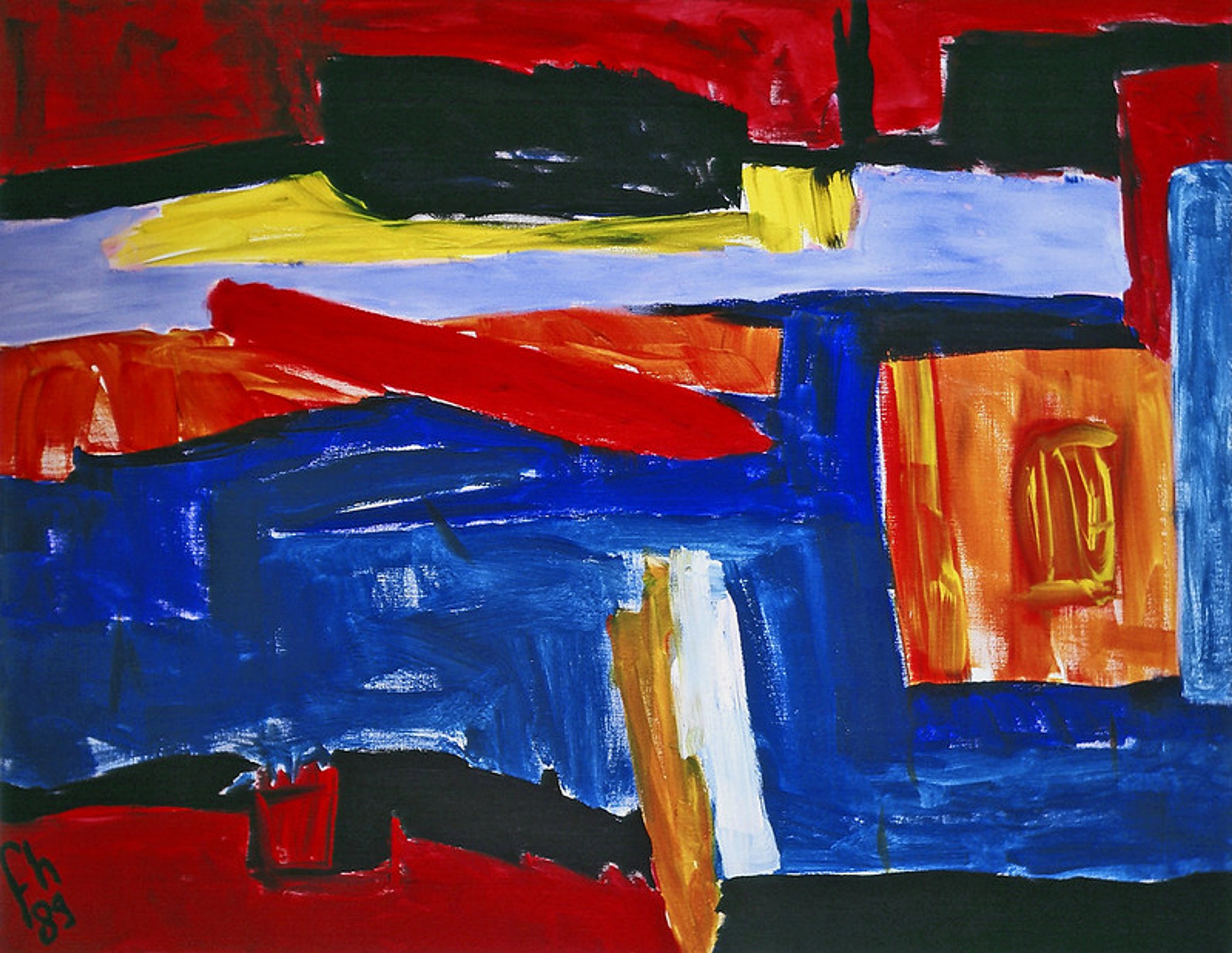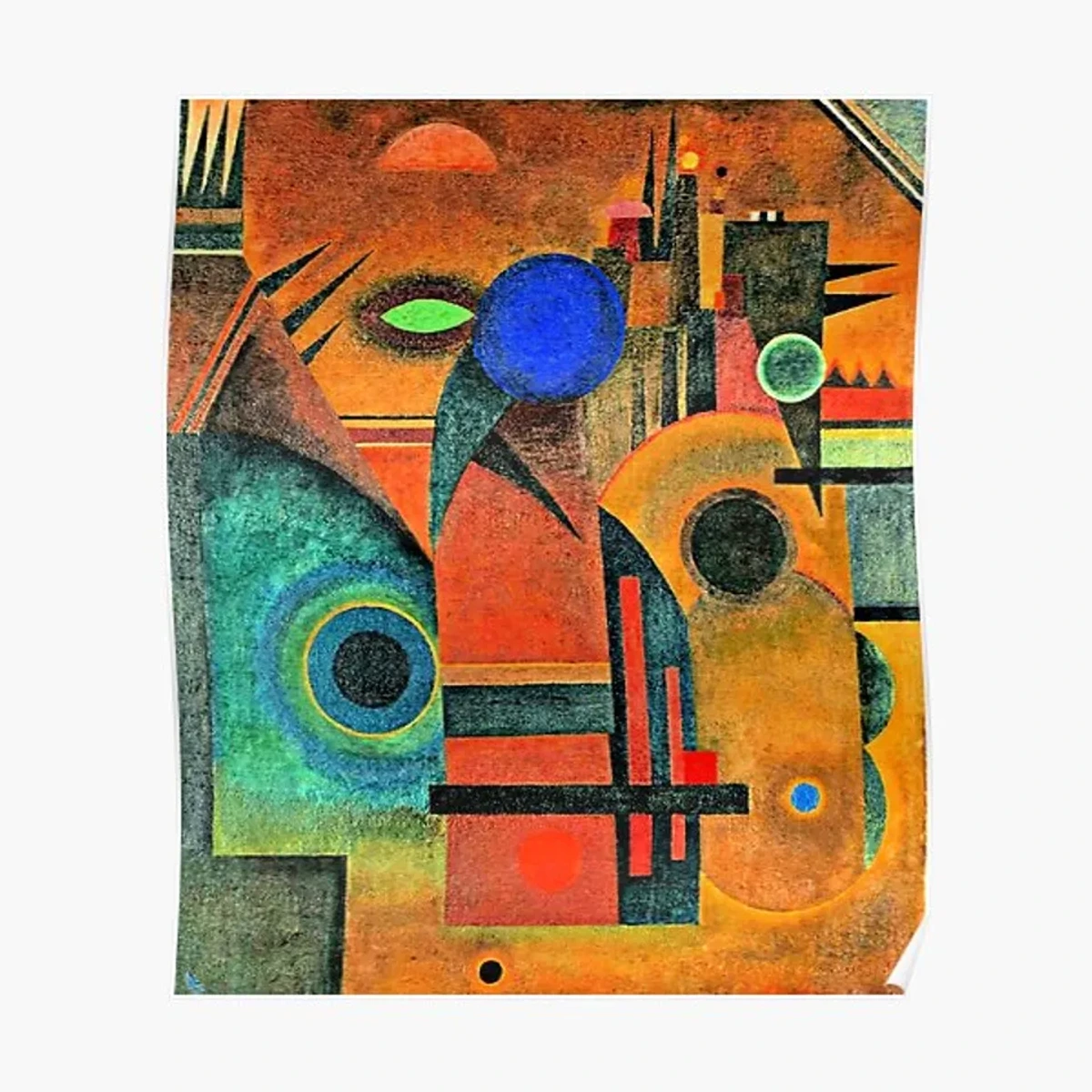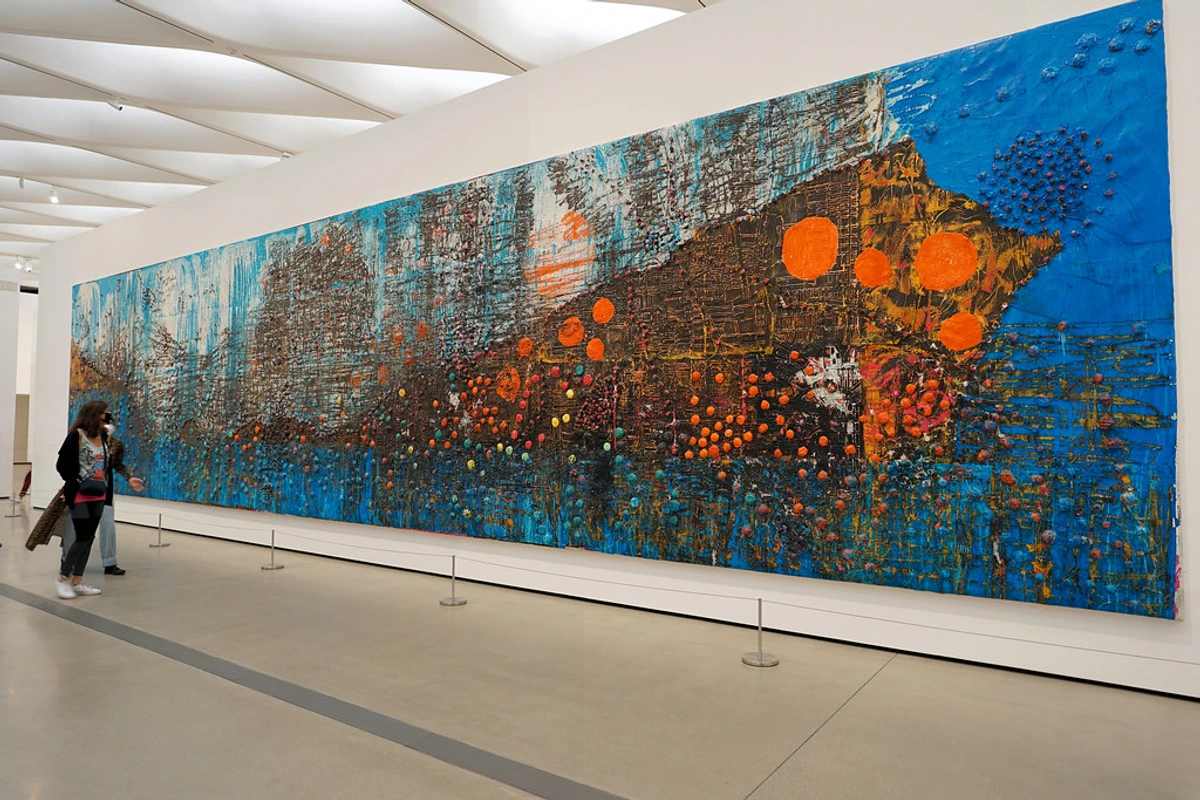
Abstract Art & Mindfulness: Finding Inner Peace Through Visual Contemplation
Uncover a profound path to inner peace through abstract art. Explore how mindful observation and personal reflection on non-representational works can quiet an overactive mind, foster emotional insight, and enrich your daily well-being.
Mindful Moments: How Abstract Art Can Be a Gateway to Inner Peace
I've always been a bit of a fidgeter, a chronic overthinker. My mind, bless its cotton socks, rarely takes a day off. It’s constantly buzzing with ideas, worries, grocery lists, and that one awkward thing I said in 2007. For years, I chased stillness through more traditional routes – meditation apps, long walks, even trying to count sheep (turns out, sheep are surprisingly distracting). And honestly, for a chronic overthinker like me, the idea of finding peace in something that looked like a paint explosion was, well, a bit of a stretch. But it wasn't until I truly leaned into the world of abstract art, not just as a creator but as a mindful observer, that I found a truly unique path to inner peace. It was, quite frankly, a revelation.
The Beautiful Silence of the Canvas
You see, my brain loves to label things. When I look at a landscape painting, it’s "tree," "river," "sunset." Immediately, my mind starts categorizing, judging, recalling. It's an active process, and while beautiful, it doesn't always invite stillness.
Abstract art, however, offers a different invitation. There's no recognizable subject to dissect, no story rigidly laid out. It’s just... there. A swirl of color, a bold line, a whisper of texture. And in that ambiguity, my overactive mind, for a glorious moment, finds itself with nothing to latch onto. It can't label. It can't judge against a preconceived notion of reality. Instead, it's gently invited to simply be – and oh, what a release that is. It’s like the hum of a thousand thoughts suddenly fades into a spacious, quiet expanse, as if a visual static clears, leaving behind a pristine screen. This isn't just a mental trick; it’s almost physical, a feeling of deep exhale, a moment of profound non-doing, like the gentle untensing of shoulders you didn't even realize were hunched.
This profound connection to inner experience isn't just my personal discovery; indeed, from its very origins, abstract art often sought to express the inexpressible, to delve into inner worlds rather than outer realities. Figures like Kandinsky, for instance, envisioned art as a spiritual endeavor, a way to connect with deeper truths beyond mere representation. And when you look at a piece like Kandinsky's "Brown Silence," pictured below, you can almost feel that aspiration – a complex arrangement inviting contemplation rather than quick categorization. This pursuit of the inexpressible echoes through various philosophical and spiritual traditions that influenced early abstract movements, reminding us that art has long been a conduit to inner realms. Think also of Hilma af Klint, whose intensely spiritual visions directly informed her pioneering abstract works, long before many male contemporaries, driven by her belief in art as a medium for communicating spiritual truths.
This profound experience of non-judgmental observation is, in essence, the core of mindfulness. And abstract art? It's a surprisingly effective, and often visually stunning, meditation prompt.
If you've ever felt a bit lost trying to "get" abstract art, know you're not alone. I’ve been there. But what if "getting it" isn't the point? What if it's about feeling it? This shift in perspective is something I've explored further in my piece on demystifying abstract art: a personal guide to finding meaning, which might resonate if you're curious about this kind of inner shift.

Your Inner World, Mirrored in Abstraction
What if the canvas isn't just a window to another world, but a mirror reflecting your own internal landscape back to you?
One of the most powerful aspects of abstract art for mindfulness is its ability to act as a mirror. Without a clear external subject, the art becomes a canvas for your internal landscape. What emotions does that fiery red evoke? Does that sprawling blue suggest calm or melancholy? Does a sharp, angular form feel unsettling, or does a flowing, organic shape bring comfort? There’s no right or wrong answer, only what you feel.
For me, that fiery red might initially stir a subtle anxiety, a flicker of restlessness. But as I breathe with it, letting go of the urge to name it, it often transforms into a vibrant, raw energy, a reminder of my own capacity for feeling. And that sprawling blue? Sometimes it's the comforting embrace of a deep calm, other times a gentle echo of a passing melancholy, both equally valid. In my own work, for instance, a piece like 'Azure Ascent' with its soft, layered blues and subtle upward-sweeping forms, often seems to invite a deep breath and a sense of quiet expansion in viewers. Conversely, my 'Fragmented Rhythm,' with its bolder, broken lines and contrasting hues, might stir a feeling of vibrant energy or even productive tension, reflecting the dynamic complexities of inner life.
It's a concept I explored in finding your reflection: how abstract art can be a mirror to your inner world. This isn't about projecting meaning onto the art, but allowing the art to reflect the emotions and thoughts already residing within you. It's a gentle, non-verbal dialogue with yourself.
Consider the emotional language of color in abstract art or the role of texture in abstract art: a sensory exploration. These elements, free from representational constraints, speak directly to your subconscious. A rough, impasto texture, like the scraped effect in Richter's 'Abstract Painting (726)' shown above, might evoke a sense of struggle or resilience, while smooth, flowing lines could feel serene. Richter's technique of applying thick layers of paint and then pulling it across the canvas with a squeegee creates a distinct visual language of layers and revelations, directly mirroring the complex, often obscured, layers of our own emotional truths. It's deeply personal, and that's its strength.

https://live.staticflickr.com/65535/53064827119_1b7c27cd96_b.jpg, licence
Practical Steps to Mindful Art Engagement
So, how do you actually do this? How do you turn a piece of abstract art into a personal sanctuary for peace? It's simpler than you might think, and thankfully, requires no special equipment or guru status. Just a willingness to slow down. You don't need a gallery, a degree, or even a perfectly quiet house – just a few moments and an open mind, ready to engage with the visual anchor.
Hermit’s informal guide:
- Find Your Piece: Choose an abstract artwork that genuinely draws you in. It doesn't have to be a masterpiece, just something that catches your eye. Perhaps something from my art for sale collection calls to you, or a piece you admire online.
- Create Your Space (Even a Mini One): Find a quiet spot where you won’t be disturbed. Turn off notifications. Grab a cup of tea. It's like preparing for a mini-retreat.
- Breathe and Observe: Before anything else, take a few deep, intentional breaths. Look at the art. Don't try to analyze it, just let your eyes wander. Notice the colors, the lines, the shapes, the textures. Are there areas of focus, or does your gaze drift?
- Feel, Don't Think: As you observe, notice any sensations or emotions that arise. A tightness in your chest? A feeling of spaciousness? A sudden memory? Don't cling to them, just acknowledge them. This is the art of mindful viewing: how abstract art can enhance your daily well-being.
- Let Go of Judgment: This is perhaps the hardest part for my brain – it's like trying to tell a squirrel not to bury that nut, utterly futile at times! My brain often resists stillness, perhaps fearing it'll miss out on a good worry, or forgetting that crucial grocery item. It's a constant, gentle redirection, like coaxing a stubborn cat onto your lap. Resist the urge to label it "good" or "bad," "ugly" or "beautiful." Just observe. The art isn't trying to be anything other than what it is, and neither should your experience of it.
- Stay as Long as You Like: There’s no timer. Spend a minute, spend twenty. When your mind starts to wander (and it will, mine always does, usually to thoughts of unattended laundry or that one time I accidentally wore two different socks!), gently bring your attention back to the artwork, to your breath. If you find yourself consistently distracted, or feeling nothing at all, that's okay too. Just acknowledge it without judgment and gently return your focus. Sometimes, simply observing the distraction is the mindfulness.
This practice, even for a few minutes a day, can be incredibly grounding. It’s not unlike meditation, but with a vibrant, visual anchor. And honestly, it's far less intimidating than trying to empty my mind completely, which, let's be real, feels impossible most days.
Step | Purpose/Benefit |
|---|---|
| Find Your Piece | Personal connection, visual anchor |
| Create Your Space | Minimize distractions, set intention |
| Breathe & Observe | Grounding, present moment focus |
| Feel, Don't Think | Access intuition, bypass labels |
| Let Go of Judgment | Non-attachment, pure observation |
| Stay as Long as You Like | Self-paced, deep immersion |

https://live.staticflickr.com/65535/52756888197_ece375ce5f_b.jpg, licence
The Ripple Effect: Peace Beyond the Canvas
What if the quiet moments spent with a painting could ripple out, transforming your daily interactions and shaping your very approach to life?
What starts as a few mindful moments with a painting often spills over into other areas of life. That newfound ability to observe without immediate judgment? It's invaluable when dealing with a tricky situation at work or a frustrating moment at home. For me, a concrete example: before, a sudden traffic jam might send my thoughts spiraling into frustration. Now, I often find myself observing the rhythm of the brake lights, the abstract shapes formed by the car in front, or the interplay of city lights, turning a stressful moment into a brief, almost meditative observation. Or, in a more mundane example, folding laundry, which used to feel like a tedious chore, can now become a practice of noticing the textures, the colors, the simple act of tidying, a quiet, focused movement. It's not magic, just a shift in focus that started with staring at a canvas. And my greatest hope is that the art I create might, for others, become a similar silent companion, a visual anchor for their own moments of peace.
The quiet acceptance you find in front of an abstract piece can begin to permeate your daily interactions. This practice has not only informed how I view art, but also how I approach my own creative process. Embracing intuition, letting the colors and forms guide me rather than a rigid plan – it's a very similar mindset. I find myself less concerned with a perfect outcome and more with the intuitive flow of the brush, allowing the canvas to guide me in a way I never did before, embracing the beautiful mess. And for me, the artist, the act of creation itself becomes a moving meditation, a dance with color and form, a quiet conversation with the canvas. It's a continuous loop of observation and expression, each stroke a moment of focused presence. You can read a bit about that journey in my creative process: from concept to canvas in abstract art. It's a messy, beautiful, and often surprising path, just like life itself.
And if you're ever near 's-Hertogenbosch in the Netherlands, I invite you to visit my artist's museum. There's something truly special about experiencing art in person, allowing its presence to fill a room and, perhaps, quiet the chatter in your mind. My timeline also shares more about my journey and how I arrived at these insights.

https://www.flickr.com/photos/abstract-art-fons/30634352376, licence
Still curious? Let's dive into some common questions I often hear about this practice:
Frequently Asked Questions About Abstract Art & Mindfulness
Q: Does all abstract art work for this practice?
A: Not necessarily. While the potential is there, some abstract art is intentionally jarring or chaotic, which might initially stimulate the mind rather than quiet it. However, even these pieces can offer a different kind of mindful engagement once you're comfortable with the practice, perhaps by focusing on their energy or rhythm. For true stillness, you might find yourself gravitating towards pieces with flowing lines, harmonious colors, or a sense of depth and spaciousness – perhaps more lyrical abstraction or serene color field paintings. But ultimately, it's deeply personal, and the journey of discovery is part of the practice.
Q: Do I need to know about art history or the artist's intent?
A: Absolutely not! For this particular practice, historical context and artist intent are secondary. The goal is a personal, present-moment experience. Let go of the need for academic understanding.
Q: What if I don't "feel" anything when looking at it?
A: That's perfectly fine! Mindfulness isn't about achieving a specific feeling, but about observing what is. Maybe you feel boredom, or restlessness. Acknowledge that. The "feeling" is the observation itself. Keep practicing, and sensations might shift over time. Just like a muscle, mindful observation strengthens with use.
Q: Can creating abstract art be a mindful practice?
A: Absolutely! For me, the act of creation is a profound form of moving meditation. It's about letting go of control, allowing intuition to guide the brush, and being fully present with the colors, textures, and forms as they emerge. It's not about achieving a perfect outcome, but about the process itself – the flow, the exploration, the quiet dialogue between artist and canvas. It's a beautiful way to practice mindfulness through active engagement rather than passive observation.
Q: Can I collect abstract art specifically for well-being?
A: Absolutely! Many people find that surrounding themselves with art that evokes a sense of calm, joy, or introspection contributes significantly to their home's atmosphere and their own mental well-being. Consider curating joy: integrating colorful abstract art into your home decor for ideas.
Q: How does mindful art engagement compare to traditional meditation?
A: While both aim to cultivate present-moment awareness and reduce mental chatter, mindful art engagement offers a visual anchor, making it potentially more accessible or engaging for some, especially those who struggle with "empty mind" meditations. It leverages the visual sense to draw attention, whereas traditional meditation often focuses on breath or bodily sensations. Think of it as a guided visual meditation, where the artwork itself provides the cues.
Q: What if I feel intimidated by abstract art or don't know where to start?
A: That's a common feeling! Many people are taught to look for recognizable objects or stories in art, and abstract art challenges that. The best way to start is simply to approach it with curiosity, not judgment. Pick one piece that catches your eye, even for a moment, and just observe. Don't worry about 'getting it' or understanding it. Focus on how it makes you feel, or what colors or shapes draw your attention. Remember, there's no right or wrong way to experience it, only your way. Just like starting any new mindfulness practice, patience and an open mind are your best companions.
Q: Where can I find abstract art to practice this?
A: You don't need to own a masterpiece! Start by exploring art online (museum collections, art blogs), visiting local galleries or art fairs, or even looking through art books. Many public spaces, like offices or hospitals, feature abstract art. The key is to find a piece that resonates with you, even if it's just for a few minutes in passing.
Conclusion: A Peaceful Canvas Awaits
Finding inner peace in our increasingly busy world can feel like a daunting task. For me, the journey unexpectedly led me to the vibrant, mysterious, and utterly captivating world of abstract art. It's not just about what hangs on your wall; it's about the space it creates within you.
So, the next time you encounter an abstract piece, whether it's in a gallery, online, or perhaps even one of my own creations, don't just look at it. Breathe with it. Allow it to be a gateway, however brief, to those quiet, mindful moments we all so desperately need. Your inner peace might just be waiting on a canvas. And what about you? What quiet moments might be waiting for you on a canvas, just waiting to be discovered? I'd love to hear about your own mindful moments with abstract art in the comments below! Share how a particular piece has quieted your mind or opened a new perspective.




